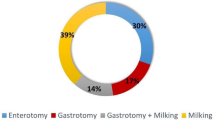Abstract
Purpose
The purpose of this study was to compare the results of surgical procedures applied to rare intestinal obstruction cases due to bezoars and to identify effective factors for determining the type of surgical procedure to be applied.
Methods
The records of 62 patients who had received gastrointestinal surgical treatment due to bezoars were assessed retrospectively. The preoperative characteristics, perioperative findings and postoperative results of cases that had and had not undergone an enterotomy were compared
Results
The average patient age was 57.7 years (range, 26–84 years), and all patients had phytobezoars, except one. The most common location for bezoars was the jejunum (28 cases, 45.1 %). Sixteen cases (25.8 %) had multiple bezoars located in different parts of the gastrointestinal tract. While milking was applied to 26 cases (41.9 %) with small intestinal bezoars, an enterotomy was used to remove bezoars in 23 cases (37 %). More complications tended to be identified in patients who underwent an enterotomy; however, the difference was not significant (p = 0.553).
Conclusions
The frequency of previous abdominal surgery in patients suffering from an intestinal obstruction due to bezoars causes diagnostic conflict. The location of bezoars in the small intestine should also be considered when deciding the surgical procedure, as well as the physical properties of the bezoars. Our opinion is that conducting the milking procedure should not be insisted on, and that an enterotomy should be conducted when necessary.


Similar content being viewed by others
References
Andrus CH, Ponsky JL. Bezoars: classification, pathophysiology, and treatment. Am J Gastroenterol. 1988;83(5):476–8.
Kadian RS, Rose JF, Mann NS. Gastric bezoars—spontaneous resolution. Am J Gastroenterol. 1978;70(1):79–82.
Erzurumlu K, Malazgirt Z, Bektas A, Dervisoglu A, Polat C, Senyurek G, Yetim I, Ozkan K. Gastrointestinal bezoars: a retrospective analysis of 34 cases. World J Gastroenterol. 2005;11(12):1813–7.
Peck JJ, Milleson T, Phelan J. The role of computed tomography with contrast and small bowel follow-through in management of small bowel obstruction. Am J Surg. 1999;177(5):375–8.
Kirshtein B, Roy-Shapira A, Lantsberg L, Avinoach E, Mizrahi S. Laparoscopic management of acute small bowel obstruction. Surg Endosc. 2005;19(4):464–7.
Gayà J, Barranco L, Llompart A, Reyes J, Obrador A. Persimmon bezoars: a successful combined therapy. Gastrointest Endosc. 2002;55(4):581–3.
Escamilla C, Robles-Campos R, Parrilla-Paricio P, Lujan-Mompean J, Liron-Ruiz R, Torralba-Martinez JA. Intestinal obstruction and bezoars. J Am Coll Surg. 1994;179(3):285–8.
Rubin M, Shimonov M, Grief F, Rotestein Z, Lelcuk S. Phytobezoar: a rare cause of intestinal obstruction. Dig Surg. 1998;15(1):52–4.
Chisholm EM, Leong HT, Chung SC, Li AK. Phytobezoar: an uncommon cause of small bowel obstruction. Ann R Coll Surg Engl. 1992;74(5):342–4.
Dirican A, Unal B, Tatli F, Sofotli I, Ozgor D, Piskin T, Kayaalp C, Kirimlioglu V. Surgical treatment of phytobezoars causes acute small intestinal obstruction. Bratisl Lek Listy. 2009;110(3):158–61.
Swift RI, Wood CB, Hershman MJ. Small bowel obstruction due to phytobezoars in the intact gastrointestinal tract. J R Coll Surg Edinb. 1989;34(5):267–9.
Kim JH, Ha HK, Sohn MJ, Kim AY, Kim TK, Kim PN, Lee MG, Myung SJ, Yang SK, Jung HY, Kim JH. CT findings of phytobezoar associated with small bowel obstruction. Eur Radiol. 2003;13(2):299–304.
Taourel PG, Fabre JM, Pradel JA, Seneterre EJ, Megibow AJ, Bruel JM. Value of CT in the diagnosis and management of patients with suspected acute small-bowel obstruction. Am J Roentgenol. 1995;165(5):187–92.
Bedioui H, Daghfous A, Ayadi M, Noomen R, Chebbi F, Rebai W, Makni A, Fteriche F, Ksantini R, Ammous A, Jouini M, Kacem M, Bensafta Z. A report of 15 cases of small-bowel obstruction secondary to phytobezoars: predisposing factors and diagnostic difficulties. Gastroenterol Clin Biol. 2008;32(6–7):596–600.
Quiroga S, Alvarez-Castells A, Sebastià MC, Pallisa E, Barluenga E. Small bowel obstruction secondary to bezoar: CT diagnosis. Abdom Imaging. 1997;22(3):315–7.
Hoover K, Piotrowski J, St Pierre K, Katz A, Goldstein AM. Simultaneous gastric and small intestinal trichobezoars—a hairy problem. J Pediatr Surg. 2006;41(8):1495–7.
Wang YG, Seitz U, Li ZL, Soehendra N, Qiao XA. Endoscopic management of huge bezoars. Endoscopy. 1998;30(4):371–4.
Lin CS, Tung CF, Peng YC, Chow WK, Chang CS, Hu WH. Successful treatment with a combination of endoscopic injection and irrigation with coca cola for gastric bezoar-induced gastric outlet obstruction. J Chin Med Assoc. 2008;71(1):49–52.
Ghosheh B, Salameh JR. Laparoscopic approach to acute small bowel obstruction: review of 1061 cases. Surg Endosc. 2007;21(11):1945–9.
Sosa J, Gardner B. Management of patients diagnosed as acute intestinal obstruction secondary to adhesions. Am Surg. 1993;59(2):125–8.
Seror D, Feigin E, Szold A, Allweis TM, Carmon M, Nissan S, Freund HR. How conservatively can postoperative small bowel obstruction be treated? Am J Surg. 1993;165(1):121–6.
Assalia A. Small-bowel obstruction secondary to bezoar impaction: a diagnostic dilemma (invited commentary). World J Surg. 2007;31:1079–80.
Ho TW, Koh DC. Small-bowel obstruction secondary to bezoar impaction: a diagnostic dilemma. World J Surg. 2007;31(5):1072–8.
Nobili P, Dassi FL, Annolfi B, Ronchi O. Intestinal obstruction due to phytobezoars. G Chir. 1993;14(1):41–4.
Lo CY, Lau PW. Small bowel phytobezoars: an uncommon cause of small bowel obstruction. Aust N Z J Surg. 1994;64(3):187–9.
Aysan E, Demir M, Kinaci E, Basak F. Complications of intestinal milking: experimental model. ANZ J Surg. 2005;75(5):322–5.
Conflict of interest
None.
Author information
Authors and Affiliations
Corresponding author
Rights and permissions
About this article
Cite this article
Altintoprak, F., Dikicier, E., Deveci, U. et al. Intestinal obstruction due to bezoars: a retrospective clinical study. Eur J Trauma Emerg Surg 38, 569–575 (2012). https://doi.org/10.1007/s00068-012-0203-0
Received:
Accepted:
Published:
Issue Date:
DOI: https://doi.org/10.1007/s00068-012-0203-0




